Fishing the Lower McKenzie River: A rainy day in early March, the McKenzie is much lower than normal spring flows. Ethan Nickel, Chris and I put in on the lower river after lunch, and the fish are rising at the boat ramp.
The action starts on river left before we’re even ten feet from the put in. Trout are already plucking at Ethan’s swung flies, while he is anchored up. We string up rods with softhackle wet flies, two flies per rod on a dropper set up and start to make our way downriver.
The fish seem to be everywhere. They’re not really rising yet and the hatch hasn’t quite started, but every spot we swing we get a tug or a nip, or a big pull. I’m farming more fish than I’m hooking. Several months of fishing the thingamabobber or giant leech program have ruined my ability to deal with delicate trout takes. Chris hooks and lands enough fish for me to confirm that it’s my abilities that are in question. Next time out, I’m bringing my bamboo four weight to slow down my casting and my hook set!
At a bend in the river where a major tributary dumps muddy water into the McKenzie, the cutthroat population shows up in earnest and there are doubles – two fish on a single swing, on multiple casts. There are too many grabby trout for me to not hook fish, and eventually my trout hooking skills start to slowly come back to me.
Far out in the heavier flow on the inside bend, Chris hooks one of the big native redside rainbow trout this river is famous for, and after a short but strong fight, he brings it in. The fish is gorgeous, spawning colors blazing on its sides. But it has a huge hole in its back with scratches down both sides – probably narrowly escaped the talons of an osprey.
At this point the March Browns show up on the water’s surface. Big dark brown sail boats with tan segmented bodies. The first major hatch I’ve seen this year, and the bugs are huge. Close to size 10. The fish react accordingly and start to pop on the surface all down both sides of the river. We push on, skipping the froggy water where the smaller fish like to feed and look for prime holding spots with big risers.
Anchored in the middle of a big flat, we start to see some splooshing big takes on the surface, and we’re picking up fish on nearly every cast. Then something blows up six feet from our right oar. A huge trout for sure. Chris hands Ethan a rod and he dead drifts the two wet flies over where we’d seen the rise, and I watch a red flash that looks like a two-liter Coke bottle break the surface and run upstream.
The trout is massive, and it runs around the big flat while Ethan jumps out of the oarsman seat and Chris starts to row us to shore. When the fish comes to hand, I can hardly believe it’s the same species of trout people are used to seeing on this river. It’s one of the largest trout Chris, Ethan or I have ever seen on the McKenzie, and it looks more like a steelhead.
Ethan quickly frees the huge trout while I snap photos like crazy. It’s a gorgeous fish, but it’s clearly an old buck, you can see the age in its fins and its slightly sunken in eyes. The body is like a football, round and deep and the bright red stripe runs all the way from its tail to its jaw.
Soon after we release the fish the hatch tapers off, probably around 2:30. We catch a lot more fish swinging wet flies, but that huge trout effectively ended the day for all of us.
Notes from the guides: How to swing flies on the McKenzie
While we were fishing, I ran my tape recorder and got the following advice from Chris and Ethan:
Why swing two flies? Sometimes you get doubles. Sometimes on the upper fly I’ll put a bead head on to keep the flies from skating on top in the faster water. But honestly, two flies give you two chances. Even though the upper fly is on a much heavier tippet, the fish don’t seem to mind much.
A team of flies is always better. The other thing is you can experiment with different patterns. Sometimes on a bright day a drab fly works better, and on a cloudy overcast day you want to specifically match the hatch.
What is the leader set up? Leader length is 9-10 feet, tapered leader cut in half. Tie a blood knot and run the upper fly off the blood knot with a 2x loop to loop dropper. This is the most tangle-free way to go. See Chris’ explanation in the video below:
By setting it that way, you can replace the dropper as often as you want. Vary the fly very easily. If you get into a good hatch and want to go dry really quick, you cut the dropper off and you have a standard nine foot leader. You can also cut off the dropper, tie a dry fly onto the end of the leader, and you’re in business.
Fly patterns for swinging in early spring? March brown are the first major hatch of the year. Start early in the hatch with bigger bugs, size 12. By later in March you might be using a smaller size 14 fly. There are a lot of productive patterns and it pays on certain days, when you’re favorite thing isn’t working well to experiment.
What are the water conditions you’re looking for? The lower McKenzie River can fish very well quite high or pretty low like it is now. You can have great fishing down here when the water is as high as 7000 cubic feet at Springfield, and today it’s half that – 3,500 cfs and conditions are great.
Medium to shallow riffles and flats are prime water, but if the fish are on emerging bugs, anywhere you see a fish coming to the surface to a fly is swingable. Out of a drift boat, larger flats and longer riffles are great. But you can have a lot of success swinging off short drops and gravel bars too.
March Browns are a clinger nymph, and they live in the highest concentration in small gravel that is fairly well oxygenated. You see a ton of them at the tops of riffles where there’s a little current. You’ll see duns all over the place.
Why swing wet flies? There are a lot of fish that feed just below the surface that may not be keyed in to the duns on top yet. Oftentimes, if we spend a full day fishing this time of year you start out nymphing when its colder, later in the morning you start to swing and later you can have dry fly fishing after that.
You can also cover more water. You’re not trying to get a dead drift in a single lane. You’re getting big sweeps across spots that are very broad. It’s a very effective way to cover water.
Rod selection for swinging flies? I love a nine foot four weight for the McKenzie. I would argue that a very stiff, heavy rod is not a good choice for swinging wet flies. We’re not using really light tippets, but you want a medium action rod that will bend more, offer more tippet protection. Fish are eating this on a tight line.
It’s a dry fly presentation. You’re trying to land it softly with a classic wet fly swing. Down and across, you’re tight with the swing. You want to be in touch with your fly, medium to short, trying to keep a straight line between your rod and your fly. If you get big bellies in the line, you’ll be less successful.
The other issue, when the fish tugs at it, you’re tugging back at it fairly hard. Just like swinging a wet fly for steelhead, the fish is bringing the line tight. Before setting the hook, you want to hesitate and then just give it a really soft little lift. If you set it a lot harder, you’ll find that you’re missing the majority of them.
Top march brown patterns at the shop:
Partridge and pheasant soft hackle
Beadhead Partridge and pheasant March Brown
Beadhead March Brown emerger
Hare’s Ear Softhackle
March Brown Wet
March Brown Softhackle Spider
March Brown Sparkle Dun
Klinkhammer March Brown
March Brown Parachute
Fly Tying Videos: Top March Brown patterns
March Brown Soft Hackle
March Brown Wet
March Brown Sparkle Dun
March Brown CDC Emerger
Klinkhammer March Brown Emerger
March Brown Parachute
Dark Cahill Wet Fly
Hare’s Ear Soft Hackle
Half-day guide trips are available at a $250 preseason rate. Call the shop for details 541-342-7005 or book online.
-MS

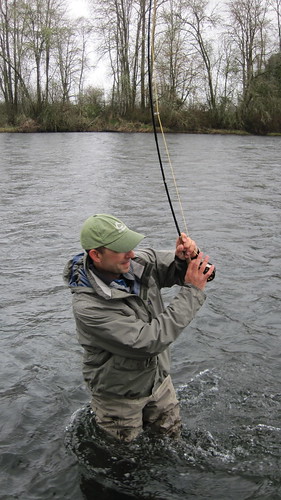

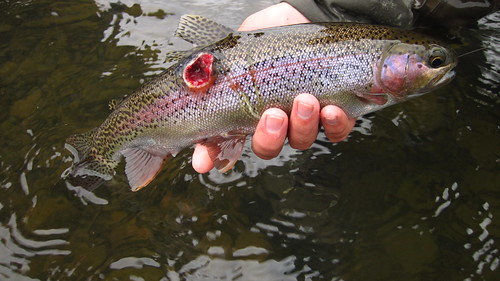
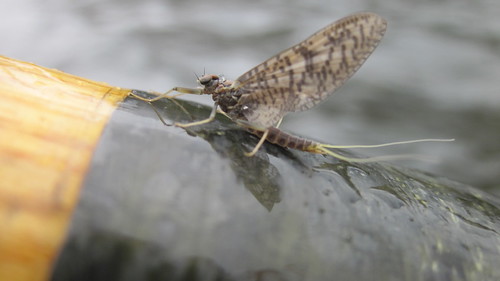
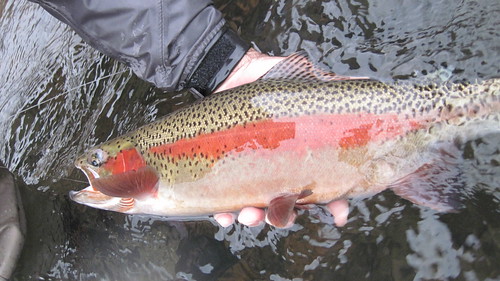

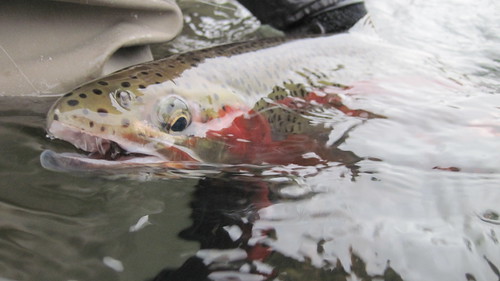
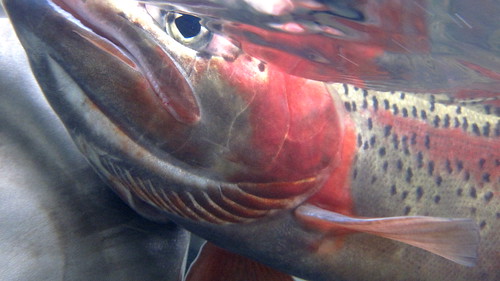
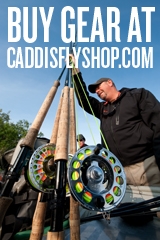


Wowie Zowie!! So THAT’s what those big redsides look like up-close! I’ve watched them porpoising for years, but have never (frustratingly) had one of those true monsters in hand. What a truly gorgeous fish!!!
Holy cow. You guys should write friggin’ book!
Awesome… that fish looks like the “model” for Brents native redside logo. Fantastic work there gents!! Look forward to hearing more from Ethan at the TU meeting.
GH
holy sh$& that fish is kick-ass
Was that is the tagging zone. It would break my heart to tag that thing
Heh… it wasn’t in the tagging zone. And I think it’d be a tough one to recapture!
I wish it was like that on Sunday out there!
Beautiful fish!
Comprehensive post, once again proving that The Caddis Fly (Chris et al) has one of the finest fly fishing blogs in the nation. By fishermen, for fishermen. Daily info, fish porn, usable beta, gear reviews, etc. Thanks and keep up the good work.
That looks like a trophy to me………awesome job and keep up the good work down there.
Great going folks… That run there holds tons of fish….. Multi- hookups abound these days!!!
Steve
Great fishing! Excellent reporting! Thanks for good info.